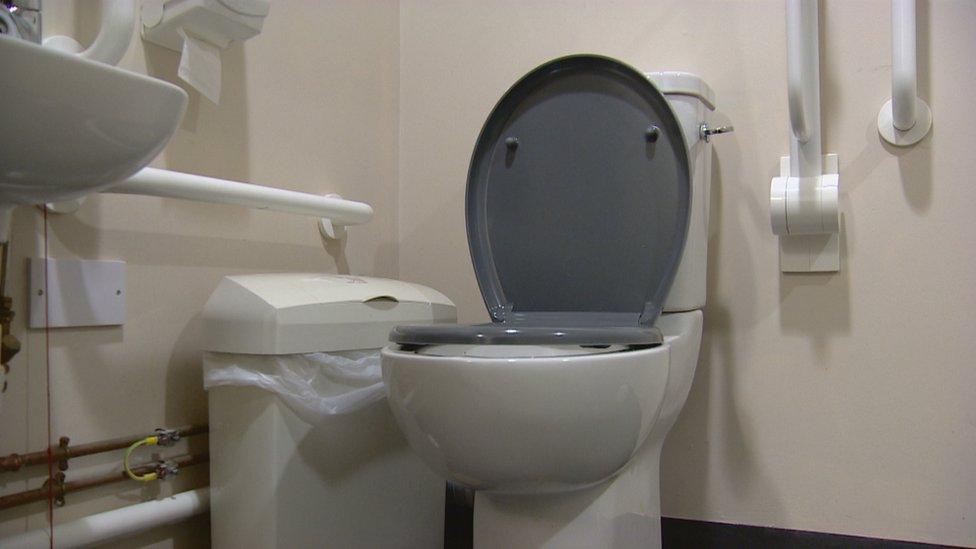What does a dementia-friendly town look like?
- Published

Aberfeldy is the latest dementia-friendly community
Aberfeldy is the latest town in Scotland to become dementia-friendly but what does that mean in practice for those living with the condition and those who care for them.
One in 14 people over 65 has dementia and that rises to one in six for people over 80.
So we probably all know someone with the condition or whose family is coping with it.
Across Scotland some towns have already taken steps to become "dementia-friendly".
Motherwell was the first, when its town centre was declared dementia-friendly in 2012.
As well as awareness training for key staff, this also involved looking at clear and concise signage, ease of navigation, lighting, seating areas and types of flooring.

Simple changes such as a toilet seat of a contrasting colour can make a world of difference
The aim was to assist someone with dementia to get around the environment as easily as possible.
Aberfeldy is the latest community become dementia-friendly.
From cafes and bookshops to the post office and the cinema, the whole community is involved.
For instance, members of the Aberfeldy Rotary club learned that a simple change of colour can make a world of difference.
They are changing the white toilet seat in a disabled toilet in a cafe to a coloured one.
This can helps people differentiate the toilet seat from the bowl, which can be confusing and embarrassing.

What changes can be dementia-friendly?

Clear signage is one dementia-friendly measure
Dementia is not just about memory but has a sensory dimension too which can mean changes in vision, making it difficult when navigating surfaces like roads and pavements, going up and down stairs or coping with noise.
Signage - Signs should be clear and concise. They should be at eye level and fixed to the doors they refer too. Signage can help people with navigation and are critical for toilets and exits. Glass doors should always be visibly marked to avoid accidents.
Orientation - Landmarks such as plants or pictures can be used by people with dementia to help with navigation.
Lighting - Entrances should be well lit and easy to access, using natural light as much as possible. Overly bright lights and shadows should be prevented where possible. Brighter primary colours can help to light up dark areas.
Seating - In large premises a seating area can be very beneficial to avoid fatigue. Seating should resemble traditional seats such as a wooden bench or chair.
Flooring / Stairs - Highly reflective and slippery floor surfaces should be avoided. Stairs should be a contrasting colour to the floor in order to show the obstacle clearly. Mats/rugs may pose an obstacle.

'Simple changes'

The Birks Cinema is taking measures to make it screenings more dementia-friendly
About 90,000 people in Scotland have dementia.
According to Alzheimer Scotland, in less than 25 years that will have increased by 75%.
Janette Barrie, from the Dementia Friendly Aberfeldy Collaborative, said they were trying to highlight simple things that make a real difference.
"If you are more informed, you can empathise with individuals and anticipate some of their needs," she said.
That includes making cinema visits less of a drama.
Watching a film should be enjoyable not daunting so the Birks Cinema is making dementia-friendly adaptations.

The cinema is taking the lights up a bit and the sound down for some screenings
John Freeman, from the cinema trust, said: "On a very practical level we can adapt our screenings and adapt the auditorium to be more suitable and flexible to be comfortable for people with dementia.
"We take the lights up a little bit and the sound down. And we promote films that are going to be friendly for people with dementia. We are starting a conversation about something that can occasionally have a stigma to it."
But does any of this actually make any difference?
Liz Smith's husband was diagnosed with dementia at the end of April.
She said: "I think anything that helps people who are caring for dementia is helpful.
"When you get the diagnosis you are going into completely unknown territory. You don't know what is available, you don't know how it's going to pan out, you don't know what you are going to need."

The large, clear face of the clock helps Carol's mother
Carol May used to work with dementia patients when she was a staff nurse. Her mother is now very elderly and she has a specialist dementia-friendly clock to help her tell the time. It shows how changes to the way information is displayed can make a huge difference.
"The clock has been a very big change for her," Carol said.
"She can now see very clearly the day of the week, the time and the time of the day as in afternoon or morning because she got that muddled waking in the middle of the night. That was a very big thing for her."
Aberfeldy is not the first place to do this and campaigners hope it won't be the last.
They think everywhere needs to become dementia-friendly because all of us are going to benefit.